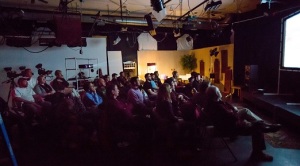In case you missed our Halloween Special or just want more, here are responses from some of the filmmakers, BTS content and photos of the event!
Filmmaker Responses:
The filmmakers were asked 2 questions: 1.Why do you make short films? 2. What can a short do that a feature can’t? Here are their answers!
Elliot Cowan
Film: The Thing In The Distance
1. Well, sometimes you’ve got a small idea and sometimes you’ve got a big idea. Small ideas do very well in a short film. If you’re very clever you can make a big idea work well in a short. Also, if you’re itching to make an animated film, starting short is the best place to start. I’ve made shorts and a feature and the challenges of a feature are insane. A short is much more manageable especially if you’re not being paid to do it full.
Does the changing way we consume media affect your filmmaking and distribution? How?
2. It doesn’t effect what I do at all. Frankly the modern method of exploring media simply means that there are more opportunities for people to see your films but less opportunities to make any money.
Thomas Tosi
Film: The October Garden
1. The obvious answer is that it costs a heck of lot less money to make a short than it does to make a feature. Besides that (and largely because of that), there’s much more freedom in making a short. With a small-budget indie feature, you can cling to the hope that, even though the odds are terribly against you, you can actually make money with the film. That hope is pretty well erased with a short film. Everybody, including the filmmaker, knows that a short film isn’t being made to make money. While that may sound like a bad thing, the upshot is that you don’t waste any effort worrying about commercial viability; you tell the story the way you feel it should be told whether it be in one minute or one hour. When that is understood by all involved, it can give short films a wonderful kind of integrity.
2. It’s almost impossible to track how many outlets there are today for media. The flip-side of that, of course, is that there is a tremendous amount of white noise. The digital age doesn’t necessarily mean that it’s easy to get an audience for your work. Also, attention spans are so short. At approximately ten minutes in length, “The October Garden” (as well as most of my other “short” films) is an epic compared to a six-second vine. These days, while I still certainly wouldn’t give away my feature scripts or feature film, I’m not so concerned about making money with my short films. YouTube, Vimeo, and the like, are merely fun ways to reach an audience for me. I suspect that I would be thoroughly frustrated if I was trying to monetize the shorts. The people I see being commercially successful (via likes, hits, and ads) with shorts on these high-technology driven channels, carefully craft their content to be “viral” and tantalizingly “clickable” (e.g. “This man handed a frog to a total stranger and you won’t believe what happened next!”). That’s not to say that some people don’t put effort into viral videos; it’s just that, more often than not, these pieces are ephemeral. Any of my work on which I expect some type of return, goes through traditional DVD sales and paid streaming, such as Amazon Instant Video.
Jeff Palmer
Film: Caveat Emptor
1. Making short format films and music videos is a great way to go through the same creative process of building something bigger, like a feature for instance, but at a fraction of what one would spend on budget and in time. After attending dozens of film festivals and viewing hundreds of films online, well-crafted shorts come in all shapes and genres, and no two are exactly alike. What seems to matter most to any audience is entertainment value. Obviously what is “entertaining” to one viewer won’t be the same for another, but if the filmmaker has done his or her work crafting a meaningful story with mindful direction and attention to detail, even the smallest and shortest of films can produce a big impact on its audience. As is often the case, big stories can come wrapped in small packages and, all too often, we find small, misguided stories filling the big theaters, which end up being more lackluster than blockbuster. I’d say that many ideas work just fine in the short format and needn’t be extrapolated or embellished into grander, glossier productions. In fact doing such can diminish the very charm that made an intimate or personal story so appealing to begin with.
2. In terms of new media and methods of distribution, I’m not in a position where that really affects my filmmaking at the moment. YouTube and outlets like Vimeo have been around long enough that anyone can play writer/producer/director and post their ‘epic’ cat videos or cooking shows for the world to watch, with varying results. Most of the shorts and music videos that I’ve produced have screened at film festivals in front of live audiences, which is always the preferred format because, typically, everyone has collected to enjoy cinema and share in that somewhat magical experience together as a group. Cell Phone Cinema is definitely not what inspires me to make movies, yet venues like Netflix, Amazon and other channels with streaming content have already become viable resources for aspiring writers and producers, especially those interested in episodic stories. Shoot it and they will watch? One can only hope!
BTS Material from the film Waste, directed by Anton Groves:
To see how the wonderful paper monsters from the film Waste were made, check out the tutorial videos here!
